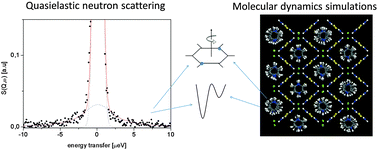In-plane pyridinium cation reorientation in bis-thiourea chloride, bromide and iodide: quasielastic neutron scattering combined with molecular dynamics simulations†
Abstract
We have studied the dynamics of

* Corresponding authors
a
Faculty of Physics, A. Mickiewicz University, Poznań, Poland
E-mail:
Aleksandra.Pajzderska@amu.edu.pl
b Institut Laue Langevin, 6 rue Jules Horowitz B.P. 156, 38042 Grenoble Cedex 9, France
We have studied the dynamics of

 Please wait while we load your content...
Something went wrong. Try again?
Please wait while we load your content...
Something went wrong. Try again?
A. Pajzderska, M. A. Gonzalez and J. Wąsicki, Phys. Chem. Chem. Phys., 2012, 14, 3949 DOI: 10.1039/C2CP23668K
To request permission to reproduce material from this article, please go to the Copyright Clearance Center request page.
If you are an author contributing to an RSC publication, you do not need to request permission provided correct acknowledgement is given.
If you are the author of this article, you do not need to request permission to reproduce figures and diagrams provided correct acknowledgement is given. If you want to reproduce the whole article in a third-party publication (excluding your thesis/dissertation for which permission is not required) please go to the Copyright Clearance Center request page.
Read more about how to correctly acknowledge RSC content.
 Fetching data from CrossRef.
Fetching data from CrossRef.
This may take some time to load.
Loading related content
